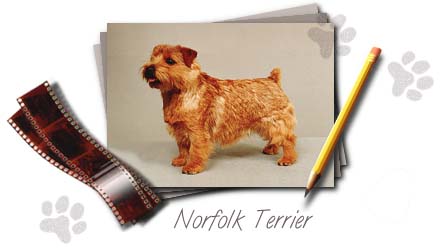History of The Norfolk and Norwich Terriers

BREIF HISTORY
Although Norfolk and Norwich Terriers share the same ancestry, there has been little interbreeding of ear types since ring competition resumed after World War II. Despite their similar Standards, 40 years and more of selective breeding have subtly differentiated the shape and character of the Norfolk from the Norwich since 1932, when Norwich Terriers received breed recognition in England. Even then, most of the pendant (drop ear or D.E.) and erect ear (prick ear or P.E.) devotees were divided into separate camps. This rift deepened after the War, with the determined Miss Marion Sheila Scott Macfie leading the charge for the drop ear cause. Convinced the more prevalent drop ears were the original breed, "Mac" did not like seeing them defeated in the show ring.
During the 1930s, six Norwich Terriers became champions--three of each ear type. Yet the decade following the War found the prick ears winning most of the honors in both England and America. This caused further tension, as the breed clubs in both countries were dominated by drop ear enthusiasts. At that time the prick ear winners led in showmanship, eyes, bites, and presentation, although it was generally conceded the drop ears excelled in coats, toplines, and movement.
The Norfolk Breed type
General Appearance
Small, low, keen dog, compact and strong, short back, good substance and bone. Honourable scars from fair wear and tear permissible.
Characteristics
One of the smallest of terriers, a ‘demon’ for its size. Lovable disposition, not quarrelsome, hardy constitution.
Temperament
Alert and fearless.
Head and Skull
Skull broad, only slightly rounded with good width between ears. Muzzle wedge-shaped and strong; length of muzzle about one-third less than measurement from occiput to bottom of well defined stop.
Eyes
Oval-shaped and deep-set, dark brown or black. Expression alert, keen and intelligent.
Ears
Medium size, V-shaped, slightly rounded at tip, dropping forward close to cheek.
Mouth
Tight-lipped, strong jaw, teeth strong and rather large; perfect scissor bite, i.e. upper teeth closely overlapping lower teeth and set square to the jaws.
Neck
Strong and of medium length.
Forequarters
Clean, well laid back shoulder blade, approximating in length to upper arm. Front legs short, powerful and straight.
Body
Compact, short back, level topline, well sprung ribs.
Hindquarters
Well muscled, good turn of stifle, hocks well let down and straight when viewed from rear; great propulsion.
Feet
Round with thick pads.
Tail
Docking of tail optional.
(a) Medium docked, set level with topline and carried erect.
(b) Tail of moderate length to give a general balance to the dog, thick at the root and tapering towards the tip, as straight as possible, carried jauntily, but not excessively gay.
Gait/Movement
True, low and driving. Moving straight forward from shoulder. Good rear angulation showing great powers of propulsion. Hindlegs follow track of forelegs, moving smoothly from hips. Flexing well at stifle and hock. Topline remaining level.
Coat
Hard, wiry, straight, lying close to body. Longer and rougher on neck and shoulders. Hair on head and ears short and smooth, except for slight whiskers and eyebrows. Excessive trimming undesirable.
Colour
All shades of red, wheaten, black and tan or grizzle. White marks or patches undesirable but permissible.
Size
Ideal height at withers 25 cms (10 ins).
Faults
Any departure from the foregoing points should be considered a fault and the seriousness with which the fault should be regarded should be in exact proportion to its degree and its effect upon the health and welfare of the dog.